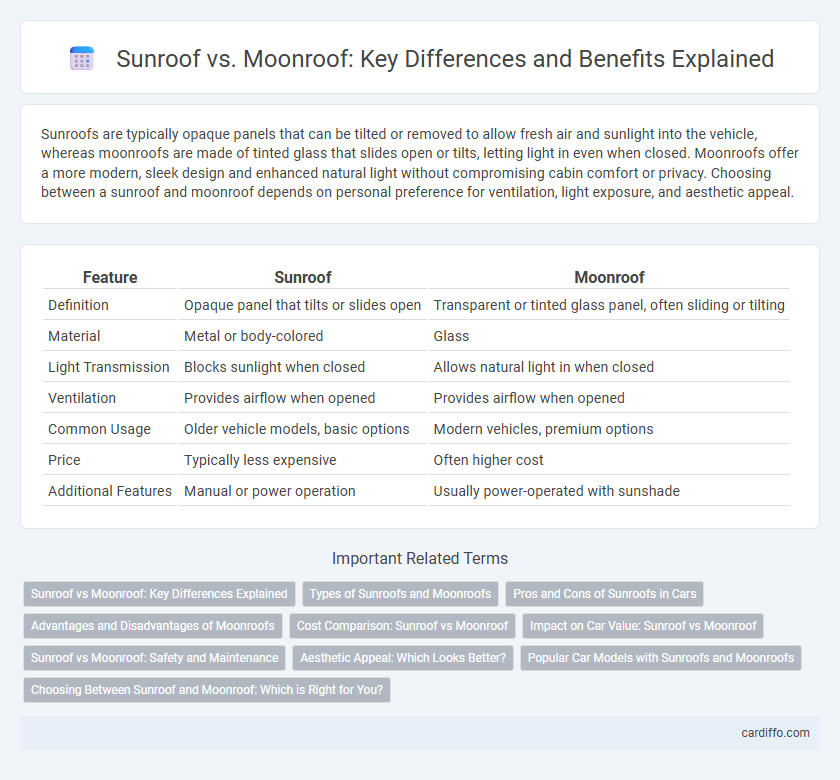Sunroofs are typically opaque panels that can be tilted or removed to allow fresh air and sunlight into the vehicle, whereas moonroofs are made of tinted glass that slides open or tilts, letting light in even when closed. Moonroofs offer a more modern, sleek design and enhanced natural light without compromising cabin comfort or privacy. Choosing between a sunroof and moonroof depends on personal preference for ventilation, light exposure, and aesthetic appeal.
Table of Comparison
| Feature | Sunroof | Moonroof |
|---|---|---|
| Definition | Opaque panel that tilts or slides open | Transparent or tinted glass panel, often sliding or tilting |
| Material | Metal or body-colored | Glass |
| Light Transmission | Blocks sunlight when closed | Allows natural light in when closed |
| Ventilation | Provides airflow when opened | Provides airflow when opened |
| Common Usage | Older vehicle models, basic options | Modern vehicles, premium options |
| Price | Typically less expensive | Often higher cost |
| Additional Features | Manual or power operation | Usually power-operated with sunshade |
Sunroof vs Moonroof: Key Differences Explained
A sunroof is a solid, opaque panel that can be tilted or removed to allow light and air into the vehicle, while a moonroof is typically a transparent or tinted glass panel that slides open or tilts, offering visibility even when closed. Sunroofs often require manual operation or can be fully detachable, whereas moonroofs are usually power-operated and provide a sleek, modern design with UV protection. Understanding these distinctions helps in selecting the best accessory to enhance vehicle ventilation and natural light preferences.
Types of Sunroofs and Moonroofs
Sunroofs commonly include pop-up, spoiler, and panoramic types, each offering distinct levels of ventilation and light exposure; pop-up models tilt open, spoilers slide back partially, while panoramic sunroofs provide expansive glass coverage across the roof. Moonroofs are a specific type of sunroof characterized by a tinted glass panel that usually slides open or tilts, allowing natural light in even when closed, enhancing cabin ambiance without compromising weather protection. Both accessories enhance driving experience by increasing natural light and airflow, but moonroofs emphasize transparency and style, whereas sunroofs prioritize varied functional options.
Pros and Cons of Sunroofs in Cars
Sunroofs in cars offer enhanced ventilation and natural light, improving the overall driving experience and cabin ambiance. However, they can reduce headroom, may lead to potential leaks if not properly maintained, and often increase vehicle cost and mechanical complexity. Despite these drawbacks, sunroofs provide a versatile option for fresh air without fully opening windows, enhancing comfort and driving pleasure.
Advantages and Disadvantages of Moonroofs
Moonroofs offer the advantage of allowing natural light into the vehicle's cabin, enhancing the driving experience without the need to fully open the roof, which can reduce wind noise and maintain better climate control. A key disadvantage of moonroofs is their potential to cause leaks or mechanical failures over time due to complex sliding mechanisms and seals. They may also reduce headroom slightly and add weight to the vehicle, potentially impacting fuel efficiency.
Cost Comparison: Sunroof vs Moonroof
Sunroofs typically cost between $800 and $1,500, while moonroofs range from $1,000 to $2,200, reflecting their advanced features and materials. Installation expenses for both vary based on vehicle type and complexity, with moonroofs often requiring more intricate labor and parts. Choosing between them depends on budget constraints and desired functionality, as moonroofs usually offer enhanced tinting and transparent glass panels.
Impact on Car Value: Sunroof vs Moonroof
Sunroofs generally have a neutral or slightly positive impact on car value due to their traditional design and proven reliability. Moonroofs, featuring tinted glass panels that often tilt or slide open, tend to enhance resale value more significantly by appealing to buyers seeking modern aesthetics and increased natural light. Market trends indicate that vehicles equipped with moonroofs often command higher prices compared to those with standard sunroofs, reflecting consumer preference for this accessory.
Sunroof vs Moonroof: Safety and Maintenance
Sunroofs and moonroofs differ significantly in safety features and maintenance requirements. Sunroofs, typically made of metal or opaque materials, offer robust protection against breakage and require minimal upkeep, while moonroofs, constructed from glass panels, demand regular cleaning and inspection to prevent leaks and cracks. Both accessories benefit from routine maintenance, but moonroofs necessitate more frequent attention to seals and mechanical components to ensure optimal safety and functionality.
Aesthetic Appeal: Which Looks Better?
Sunroofs offer a classic, streamlined look that seamlessly integrates with the vehicle's roofline, enhancing the car's overall elegance. Moonroofs, typically featuring tinted glass panels, provide a modern and sophisticated appearance that allows natural light to brighten the interior without compromising style. Choosing between sunroof and moonroof aesthetics depends on personal preference for either a traditional or contemporary design element.
Popular Car Models with Sunroofs and Moonroofs
Popular car models featuring sunroofs include the Honda Civic, Toyota Camry, and Ford Mustang, known for their classic open-air experience. Moonroofs are commonly found in luxury vehicles such as the BMW 3 Series, Audi A4, and Mercedes-Benz C-Class, offering a tinted glass panel that can be tilted or slid open. Both sunroofs and moonroofs enhance driving enjoyment by increasing natural light and ventilation in the cabin.
Choosing Between Sunroof and Moonroof: Which is Right for You?
Sunroofs offer a solid, opaque panel that tilts or slides open, providing ventilation and natural light while maintaining a sleek roofline. Moonroofs feature a transparent or tinted glass panel, often with a sliding shade, allowing more light into the cabin even when closed. Choosing between a sunroof and moonroof depends on preferences for light exposure, ventilation, and aesthetic appeal in your vehicle accessory.
Sunroof vs Moonroof Infographic

 cardiffo.com
cardiffo.com